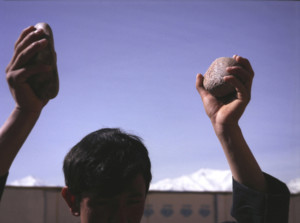Rubin Museum of Art Presents CLAPPING WITH STONES: ART AND ACTS OF RESISTANCE in August

This August the Rubin Museum of Art is presenting the third exhibition in its Year of Power programming, "Clapping with Stones: Art and Acts of Resistance."
Organized by guest curator Sara Raza, the exhibition brings together 10 contemporary artists living and working in the United States and internationally whose works poetically employ non-conformity and resistance as tools to question and upend power in society. Using a range of media - including installation, painting, photography, sculpture, video, and textile - the artists confront history, identity, heritage, and ways of understanding the world at a time when truth is censored, borders reconfigured, mobility impeded, and civil liberties challenged. Bringing together myriad voices, the exhibition presents a meditation on the spirit of defiance expressed through art.
"Clapping with Stones: Art and Acts of Resistance" will be on view from August 16, 2019, to January 6, 2020, and will feature works by Lida Abdul, Kader Attia, Nadia Kaabi-Linke, Naiza Khan, Kimsooja, Pallavi Paul, Shahpour Pouyan, Ibrahim Quraishi, Nari Ward, and Hank Willis Thomas.
Installed on the sixth floor of the Museum, the exhibition unfolds around Kimsooja's site-specific installation "Lotus: Zone of Zero" (2019). The large-scale display uses the historic building's iconic circular architecture as a framework to suspend over 200 lotus lanterns from the Rubin's oculus in a configuration resembling a mandala. Ambient sounds combine Tibetan, Gregorian, and Islamic chants to create a meditative, harmonious environment that highlights the potential for coexistence at a time of chaos. Other works in the exhibition further engage with the Museum's unique spaces and highlight the interwoven relationships among history, objects, and cross-cultural movement, including Nari Ward's new sculptural installation of a period room featuring found furniture, which explores topics of race, migration, and the transatlantic slave trade. Also on view is a monumental three-panel gold-leaf-encased triptych by Nadia Kaabi-Linke that explores Germany's fraught past through the familiar visual and architectural elements of a Christian altarpiece.
Other artworks incorporate performative gestures, such as Lida Abdul's powerful film "Clapping with Stones" (2005), from which the exhibition takes its name. The video examines the Taliban's destruction of the 6th-century Buddhas of Bamiyan in Central Afghanistan and contemplates the aftermath of the disaster. A ritualistic performance of a group of men clapping with stones takes center stage, signaling both an act of mourning and resistance. Similarly, Ibrahim Quraishi's installation "The Calling" (2008-2019) examines historical trauma and disaster through the documentation of an explosion of violins, objects with deep-seated historical and cultural significance.
Artist Shahpour Pouyan explores nationalism and belonging through an architecturally inspired sculptural installation of domes, drawing from his DIY DNA test and symbolizing his origins. In contrast, Naiza Khan explores the legacy of colonialism, history, and role of women in the Indian subcontinent as a starting point to consider beauty, violence, and power through galvanized steel sculptures. Both artists search for an understanding of identity when borders can be limits to the self. Other works in the exhibition draw from figures from the past and present. Pallavi Paul's 75-foot scroll documents the death of a former World War II Indian spy for the British government whose body was never found, questioning her death and the freedom of information. Kader Attia's video gives voice to the plight of migrant activists in Europe, highlighting the urgent issue of migration from Global South to the West, socioeconomics, and disparity. The theme of resistance is also echoed in Hank Willis Thomas's stainless steel sculpture that features two hands clashing in a moment of violence and refusal.
"The exhibition touches upon myriad artistic practices that explore non-conformity through a dynamic and non-didactic lens to create an inquiry into the manifestation of power that resides in art and society," says Sara Raza, the former Guggenheim UBS MAP Curator, Middle East and North Africa, who was invited by the Rubin in the fall of 2018 to organize this exhibition. "'Clapping with Stones: Art and Acts of Resistance' follows the artists' leads and articulates a wide variety of societal and political themes, unveiling power that exists in the unseen, hidden, and unrecorded. Through the work of these artists, the exhibition serves to explore power as both a collective and rejective force, and call to action." She adds, "Staging this exhibition at the Rubin Museum of Art creates a rare confluence of converging global ideas that are rooted in Eastern, Western, and diasporic philosophies and thinking."
A vibrant parallel to the exhibition is a series of programs in the Museum titled The Power of Non-Conformity, which includes films, talks, and tours through the end of the year.
The Rubin Museum of Art is an arts and cultural hub in New York City's vibrant Chelsea neighborhood that inspires visitors to make connections between contemporary life and the art and ideas of the Himalayas and neighboring regions. The Rubin encourages personal discoveries through its diverse array of thought-provoking exhibitions and programs, including films, concerts, and onstage conversations, as well as immersive experiences that spark new ways of seeing the world. Emphasizing cross-cultural connections, the Rubin is a space to contemplate ideas that extend across history and span human cultures. www.RubinMuseum.org
Photo Credit: Lida Abdul and Giorgio Persano Gallery
Videos

